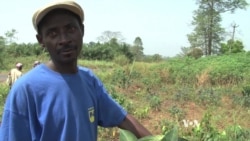The past several years of sectarian violence following a 2013 coup have left the Central African Republic’s agricultural sector devastated. Agriculture once made up 54 percent of the GDP, but, since the onset of the crisis, food production has plummeted, and food prices in the market have skyrocketed -- compromising the sustainability of agriculture and foreshadowing a deeper food crisis.
"Here we tried to grow green beans. But the seeds were of poor quality," stated one farmer, "And it didn't grow. So we grow cassava instead."
For a collective of farmers located 30 kilometers from the capital, Bangui, time has come to grow what is commonly called "crisis food", such as cassava. It takes a long time to grow and is labor intensive, but it's hard to steal and is the last resort for these farmers in a bid to survive.
When the civil war broke out in the Central African Republic a couple of years ago, many farms were looted. So some farmers have begun working the land together.
But they lack everything from machines to quality seeds, explained coordinator Felicite Ignabode. “If we don't get seeds in time and we can't plant, there will be a real food crisis. Not only for the farmer, but also for the people who depend on their production. Besides, farmers have families. If they can't feed them anymore, there is a temptation for them to give up, take up a weapon and do bad things,” said Ignabode.
The local NGO Calebasse has hired technicians to help the farmers produce more efficiently.
"Sometimes, their technique is a bit amateurish. They would grow several products on the same little plot. So we teach them to separate them and also to vary the kind of products they grow, like marrow, yam, banana. There is a market for these," explained Boris Wabie.
One market in Bangui is almost deserted. The collapse of local agricultural production and a surge of imported food provoked a sharp increase in prices.
And agriculture is not the only sector affected by it. The price of meat has also increased, said Blandine, a customer. "Prices have increased a lot. For the same amount of money, I get less quantity," Blandine said.
Trader Emmanuel Bongo justified the rising prices because of the challenges he now has to face to get meat to the stalls.
Traditionally, Muslims dominated meat production and livestock transportation. With the war, many of them fled, leaving the traders to travel further and further to get livestock.
"Now we have to get the livestock far away from Bangui, so we often encounter anti-balakas [Christian and animist militias] on the road, and they tax us," Bongo said. "Armed Peul [ethnic group] also often rob us. And, once we finally get back here, we don't have fridges to store the meat, and it goes bad very quickly."
For the U.N. Food and Agriculture Organization, social cohesion is the key to rebuiding the food industry on which different population groups depend.
So, besides providing seeds and training to farmers, agronomist Pierre Vauthier says FAO also tries to bring the Peul population back into society. "The Central African livestock keepers, which are Peul, in majority, are at the moment hidden in the bush. So we want to help them to receive services, in particular for the cattle," he stated..
Prior to the war, 70 percent of Central Africans lived off of agriculture and livestock.







